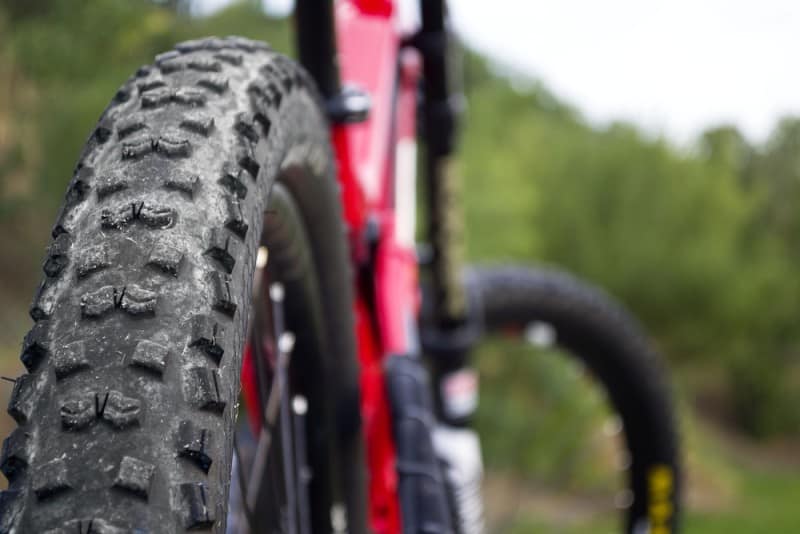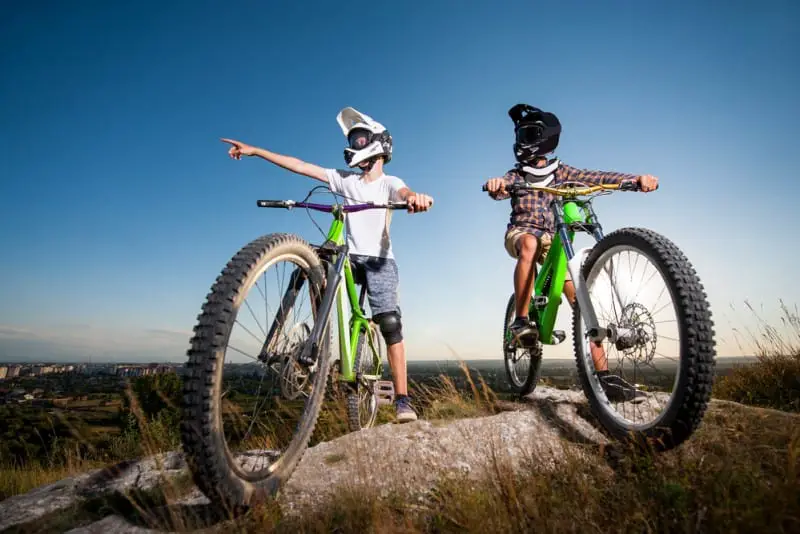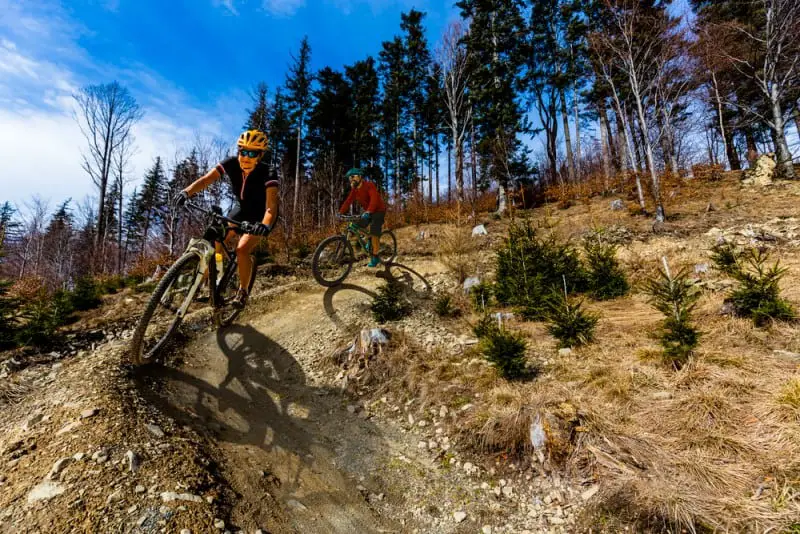Last Updated on November 2, 2023
Mountain biking can be a lot of fun, but it can also be a little confusing when you are trying to decide which type of bike is right for you. For starters, it’s essential to know that mountain bikes are made for different purposes.
For example, a trail bike will be made more for climbing, all-mountain biking, and long-distance riding, while an enduro bike will be made more for smashing the downhills and slowly spinning back up.
So, which mountain bike type is right for you: Enduro or Trail bike?
It all depends on what you’re looking for. Here’s a rundown of Trail and Enduro types to help you decide which mountain bike you should go for.
Whether you are just getting started in mountain biking or an experienced rider looking for a new challenge, we have the information you need to make the right decision!
Quick Summary:
- Trail bikes are great for climbing and long-distance riding.
- Enduro bikes are made more for smashing the downhills.
- Trail bikes are easier to control on descents.
- Enduro bikes are better for going fast on rough terrain.
- It all depends on what you’re looking for and which bike is right for you.
Trail MTB Vs. Enduro MTB: Which is Better?
Let’s jump right ahead and address the elephant in the room. Which is better? Trail MTB or Enduro MTB? As you might have guessed, the answer is that it all depends on what you’re looking for.
If you love getting out and smashing the downhills, an enduro bike will probably be the better option. However, a trail bike might be a better fit if you’re more interested in long-distance riding and all-mountain biking.
It’s not a question of which bike is better, as each variant has strengths and weaknesses. Instead, the key is determining which bike type is better suited for your riding style.
To determine that, let’s take a more in-depth look at each type of mountain bike.
Trail MTB Vs. Enduro MTB: What’s the Difference?
While they are used for different purposes, a Trail and Enduro mountain bike might look the same in the eyes of a complete beginner. After all, they are both mountain bikes designed to ride on trails, right?
Well, not quite. A few key differences set these two types of mountain bikes apart. Here’s a quick overview of the key differences between a Trail mountain bike and an Enduro mountain bike:
A key difference that can tell both MTBs apart is their suspensions. While both bikes have it, they differ in suspension travel.
Trail MTBs have slightly less suspension travel at 130 to 150 mm. On the other hand, Enduro bikes have a higher 150 to 200 mm of travel.

Trail bikes are lighter with a steeper and shorter geometry than enduro bikes. On the other hand, Enduro bikes feature slack head tube angle, slack geometry, and hefty suspensions, which are meant for downhill mountain biking.
Enduro bikes have a more aggressive riding position than Trail bikes. This is thanks to their wider handlebars and shorter stems, which give the rider more control during enduro races.
Trail MTB Vs. Enduro MTB: Geometry
Geometry is the most critical factor that sets these two types of bikes apart. Simply put, it is the angle and measurements of a bike’s frame tubes.
Bike geometry also defines how a bike will perform in different MBT disciplines. That’s why you’ll see different geometries and bike measurements on cross-country bikes, downhill bikes, and everything in between.
You can change and upgrade most components on a mountain bike. However, if the geometry is wrong, you can’t do anything about it.
Determining the differences in Geometry isn’t a generalization. The fact is, there are different areas that you need to consider. Here are the critical areas of geometry that you need to take into account:
Head Angle
Standard Enduro mountain biking states that the Average Enduro bike head angle is 62 to 65 degrees. Enduro bikes are designed for Enduro racing—they have slacker head tube angles to make them stabler on rough terrain.
While a slacker head tube is excellent for downhill tracks, it’s the opposite of climbing. A steeper head tube angle will make climbing harder and more challenging to control weight over the front wheel.
On the other hand, the average trail bike head tube angle is 65 to 67 degrees. As a result, trail bikes feature a slacker head angle than a standard cross-country bike and a steeper head angle than an enduro bike.
This design makes trail bikes feel stabler on descents than cross-country bikes while having more turning agility at slower speeds than an Enduro bike.
Bottom Bracket Height
The bottom bracket height is the measurement from the ground to the center of the bottom bracket. A higher bottom bracket will result in more pedaling clearance over obstacles.
A lower bottom bracket will result in a more planted feeling and increased stability. This is because your center of gravity is closer to the ground.
An enduro bike will have a bottom bracket height ranging from 345 to 350mm. A higher bottom bracket is essential when pedaling through rock gardens and over roots.
A trail bike will have a bottom bracket height ranging from 337 to 342mm. A lower bottom bracket provides increased stability and control on any trail.
Wheelbase Length
The wheelbase is the distance between the hubs of the front and back wheels. A longer wheelbase will result in a more stable ride at high speeds. This is because there’s more space between the front and rear wheels.
A shorter wheelbase will result in a more nimble ride. This is because there’s less space between the front and rear wheels.
An enduro bike has a longer wheelbase for more stability when descending at high speeds. This feature is essential if you want to win your next enduro race.
A trail bike will have a shorter wheelbase than an enduro bike. This is because a shorter wheelbase provides more agility when maneuvering around obstacles.
Trail MTB Vs. Enduro MTB: Alloy or Carbon Fiber Frame?
Both Trail and Enduro bikes come in both carbon and alloy frames. There are pros and cons to both materials.
Alloy
Alloy frames are cheaper than carbon frames. They’re also more durable and easier to repair if you damage them. However, alloy frames are heavier than carbon frames.
Carbon Fiber
Carbon fiber frames are more expensive than alloy frames. They’re also lighter and more comfortable to ride. However, carbon frames are more fragile and difficult to repair if you damage them.
So, which material is better? There isn’t any right or wrong answer. It all depends on your budget and riding preferences.
Trail MTB Vs. Enduro MTB: Components
The components on a mountain bike are what make it go. They include the drivetrain, brakes, suspension, and wheels.
Enduro bike components feature slightly heavier and more robust components than trail bikes. This is because enduro bikes are designed to withstand more abuse in technical trails from race enduro events.
Trail bikes have slightly lighter and more agile components than enduro bikes. This is because trail bikes are designed for speed and agility.
Suspension
One of the biggest differences between trail bikes and enduro bikes is suspension, most specifically, suspension travel. Generally, enduro bikes have more suspension travel than trail bikes at 150 to 200 mm. This is because enduro mountain biking is more rugged and aggressive.
Trail bikes tend to have around 130 to 150 mm of suspension. This is enough suspension to handle most terrain without being too heavy or slow.
Either way, both are typical features of a suspension bike, composed of rigid components that can be found at your local bike manufacturers.
For Enduro bikes, the increased suspension ensures a smoother descent while being light enough to handle uphill climbs. Unfortunately, the tradeoff is the inefficiency of Enduro bikes when it comes to long rides or pedaling up climbs—both areas where a Trail bike excels.
The extra boost in suspension for Enduro bikes will add weight, which makes pedaling harder. It’s also the reason why Enduro bikes are less efficient on flat terrain.
Wheels
Both Trail and Enduro bikes use 27.5 and 29-inch wheel variants. Some even have different wheel sizes on the front and back wheels (this is known as a mullet).
However, there’s a slight trend for Trail bikes to have bigger 29-inch wheels to allow them to travel at greater distances easily. At the same time, it also compensates for the slightly less suspension.
On the other hand, most Enduro bikes feature smaller 27-inch wheels. The reason for this is maneuverability on tighter and more technical terrain.
In terms of rims, high-end Enduro bikes tend to come with carbon rims. This trend is due to its light without sacrificing strength and performance.
Rims
Many Enduro racing professionals choose alloy rims on the back wheel because of their reliability. Alloy rims also deal with impacts better than carbon.
Enduro bikes also have wider rims and tires than Trail bikes. This is because they need to grip the ground better when going around corners at high speeds.
Tires
Trail bike tires are narrower and have less tread than Enduro bike tires. They’re designed for speed and pedaling efficiency on smooth terrain.
In addition, Trail bike tires have less sidewall protection than Enduro bike tires. This greatly improves the weight of the trail bike but will make it more prone to punctures.
Brakes
Enduro bikes usually have larger disc brakes than Trail bikes. This is because they need to be able to handle the increased speeds and weight.

Trail bike disc brakes are smaller and lighter than Enduro bike disc brakes. This is because they’re designed for pedaling efficiency and are lightweight.
Trail mountain bikes typically have a 180 mm front rotor and a 160 mm back rotor. On the other hand, Enduro downhill bikes often have a bigger 200 mm front rotor and a 180 mm back rotor.
Drivetrain
The drivetrain is the bike part that transfers power from the pedals to the wheels. It’s also responsible for shifting gears.
Enduro bikes tend to have slightly more robust drivetrains than trail bikes. But, again, this is because they’re designed for more aggressive riding.
On the other hand, Trail bikes tend to have slightly lighter and more agile drivetrains than enduro bikes. This is because trail bikes are designed for speed and agility.
In terms of gearing, both Trail and Enduro bikes use a wider range of gears. Again, this is because they need to be able to handle a variety of terrain.
However, Enduro bikes tend to have slightly taller gears than Trail mountain bikes. This is because they need to be able to handle the increased weight and speeds.
Trail MTB Vs. Enduro MTB: Can They Switch Places?
The quick answer is yes, with a few adjustments. By replacing a few key components, you can turn your Trail bike into an Enduro bike and vice versa.
For example, you can replace the tires with wider and more aggressive tires. You can also replace the brakes with bigger and more powerful brakes.
You can also install a suspension fork on a Trail bike to turn it into an uphill/downhill bike that’s ready for Enduro mountain biking. Keep in mind that this will significantly increase the weight of the bike.
On the other hand, you can install a lighter and more agile suspension fork on an Enduro bike to turn it into a Trail bike meant for local trails, comfortable riding, or long riding bikes.
But in the end, both MTBs are meant for their respective purposes. Enduro differs from Trail biking. So, switching them out may not be the best idea.
Best Trail Mountain Bikes
There are a ton of options out there. But here are our picks for the best trail bikes available online:
Mongoose Impasse Mens Mountain Bike
The Mongoose Impasse is a great example of a Trail bike. It’s designed for speed and agility on smooth terrain.
It has an aluminum frame that’s lightweight and durable. It also has a suspension fork that absorbs shocks and bumps.
The Mongoose Impasse is outfitted with 29-inch wheels that roll over obstacles with ease. It also has disc brakes that provide stopping power when you need it.
Huffy Hardtail Mountain Bike
The Huffy Hardtail Mountain Bike is another excellent trail bike that provides great value for the money. It has a durable steel frame that’s built to last and a suspension fork that smooths out the bumps.
This bike is also outfitted with 26-inch wheels that provide great traction and stability. It also has disc brakes that provide stopping power when you need it. It also has a suspension fork that absorbs bumps with ease.
Best Enduro Mountain Bikes
The best Enduro Mountain Bikes should feature all the necessary components to help you take on the most challenging terrain. Here are our picks for the best Enduro mountain bikes available online:
Santa Cruz Hightower LT Carbon CC Mountain Bike
The Santa Cruz Hightower LT Carbon CC Mountain Bike is a top-of-the-line Enduro bike that’s built for speed and aggression. It has a carbon frame that’s lightweight and durable. It also has a suspension fork that smooths out the bumps.
This bike is also outfitted with 29-inch wheels that provide great traction and stability. The Suntour disc brakes are made for aggressive riding and provide stopping power when you need it.
Diamondback Overdrive Mountain Bike
The Diamondback Overdrive is the ultimate definition of an Enduro bike. It has a durable aluminum frame that can take a beating.
The Diamondback offer premium performance with their IsoSpeed Decoupler that smoothens out the bumps. This bike also has 29-inch wheels that can take on any terrain. The Tektro mechanical disc brakes make it easy to stop and go.
Trail MTB Vs. Enduro MTB: Which Type Wins?
So, which mountain bike type wins? Ultimately, it depends on your riding style and preferences. If you’re looking for a bike great for long distances, climbing, and technical descents, a trail bike is the best choice.

If you’re looking for a bike designed for aggressive riding and smashing the downhills, then an enduro bike is the best choice.
Both bikes have their unique advantages and disadvantages. So it’s up to you to decide which bike will be the best fit for you.
The more straightforward answer to this question is determining which riding discipline of mountain biking you prefer.
You probably want an enduro bike if you’re into uphill and downhill racing. You can check the Enduro Mountain Bike Association for more info on the exact specifications of your Enduro mountain bike.
On the other hand, if you’re more into cross-country racing, all-mountain riding, or just want to go on a casual trail ride at your local bike park, you probably want a trail bike.


